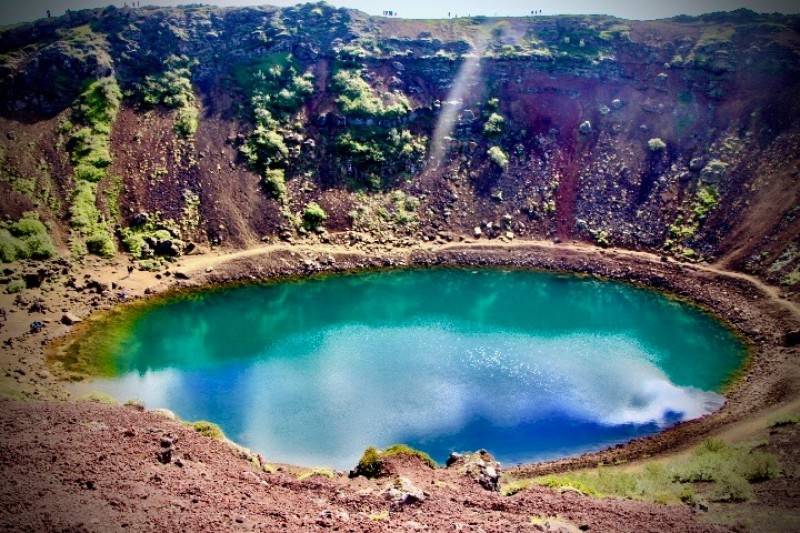Iceland Currency Guide
Everything you need to know about the Icelandic Króna, from coins and bills, to exchange tips, mobile payments, and money-saving travel advice.
Whether you're planning your first adventure or returning to explore more of Iceland's breathtaking landscapes, understanding the local currency is essential. From exchange tips to what coins to expect in your pocket, here is everything you need to know about money in Iceland.
What Currency Does Iceland Use?
Iceland uses the Icelandic Króna (ISK) as its official currency. The króna is not part of the Eurozone or tied to another major currency, making it unique and exclusive to Iceland.

Understanding Icelandic Króna
The Icelandic Króna is abbreviated as ISK and is available in both coins and banknotes:
Coins in Circulation:
- 1 ISK
- 5 ISK
- 10 ISK
- 50 ISK
- 100 ISK
Banknotes in Circulation:
- 500 ISK
- 1,000 ISK
- 2,000 ISK
- 5,000 ISK
- 10,000 ISK
Example Conversions for 1,000 ISK (approximate rates — check the live widget below for updates):
- 1000 ISK to USD: ≈ $7.20
- 1000 ISK to GBP: ≈ £5.70
- 1000 ISK to Euros: ≈ €6.70
Does Iceland Accept Foreign Currency?
In general, Iceland does not accept foreign currencies like the USD or Euro for purchases. All payments must be made in Icelandic Króna, though credit and debit cards are widely accepted.
Should I Exchange Money Before Visiting Iceland?
While you can exchange money before arrival, most travelers find it easier to use cards or withdraw ISK upon arrival. You can read more practical tips on our Iceland travel tips for first timers page.
Where Can I Exchange Money in Iceland?
Currency exchange services are available at Keflavík International Airport, banks, and some hotels. However, exchange rates and fees may vary, so it’s good to compare before exchanging large sums.
Can I Withdraw Icelandic Króna Directly at the ATM in Iceland?
Yes, you can withdraw ISK from ATMs across Iceland, including at the airport. Most machines accept international cards like Visa, MasterCard, and Maestro.
Can I pay by Card in Iceland?
Yes, credit and debit cards are accepted nearly everywhere in Iceland, from gas stations to small cafes. Just be sure your card supports international transactions.
Mobile Payments
Mobile payment options like Apple Pay, Google Pay, and contactless cards are increasingly common and accepted in Iceland.
Best to Use Cash or Card in Iceland?
While having a little cash is useful for remote areas or small services, most travelers can easily rely on cards for nearly all purchases.
Is Iceland Expensive to Visit?
Known for its high cost of living, Iceland can be expensive to visit. To help you prepare, here are a few average prices:
- Coffee: 500–700 ISK
- Beer (bar): 1,200–1,500 ISK
- Bus ticket (Reykjavík): ~500 ISK
- Fast food combo meal: 2,000–2,500 ISK
Food is often one of the most important parts of a travel budget, so be sure to check the cost of food in Iceland before you go.
Iceland Tipping Culture: Should I Tip in Iceland?
Tipping is not customary in Iceland. All service charges are included in the bill.
Handy ISK Currency Converter
Use the live currency converter below to check the latest ISK exchange rates.
Money Saving Tips When Visiting Iceland
Planning ahead can make a big difference when visiting Iceland on a budget. Here are some money-saving tips that can help you cut costs:
- Shop at duty-free on arrival
- Buy groceries at budget-friendly chains like Bónus and Krónan
- Avoid buying bottled water – Icelandic tap water is clean and free
- Cook meals when possible
- Rent a car in Iceland to explore without expensive tours
- Look for free natural attractions like waterfalls and geothermal areas
A Brief History of The Icelandic Currency
The Icelandic Króna has a long and interesting history. It was first introduced in 1874 and has evolved through political and economic changes.
What Is Featured on Icelandic Coins?
Icelandic coins are adorned with marine life and guardian spirits from Icelandic folklore.
1 ISK: A Cod Fish & The Bergrisi
Symbol of Iceland’s fishing heritage.
5 ISK: Two Dolphins & Iceland's Guardian Spirits
Represents harmony and nature.
10 ISK: Four Capelin & Iceland's Guardian Spirits
A nod to Iceland’s plentiful seas.
50 ISK: A Shore Crab & Iceland's Guardian Spirits
Marine biodiversity in Icelandic waters.
100 ISK: A Lumpfish & Iceland's Guardian Spirits
One of Iceland’s notable sea creatures that has been fished for centuries.
Who Features on The Icelandic Currency Bills?
Icelandic currency bills feature prominent figures that have shaped Icelandic history.
500 ISK: Jón Sigurðsson
Leader of Iceland's independence movement.
1000 ISK: Brynjólfur Sveinsson
A historical bishop and scholar.
2000 ISK: Jóhannes Kjarval
Famous Icelandic painter and artist.
Final Thoughts
Whether you're budgeting your trip or just want to know how much a coffee will cost, understanding Iceland's currency will make your trip smoother. Don’t forget to check out our guide to Iceland grocery stores and the cheapest time to visit Iceland for more ways to plan your visit efficiently.
